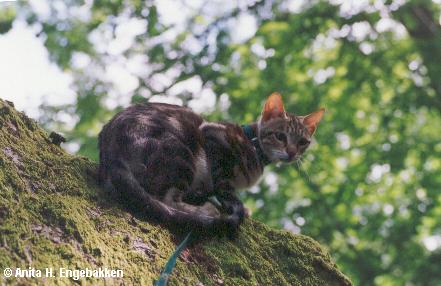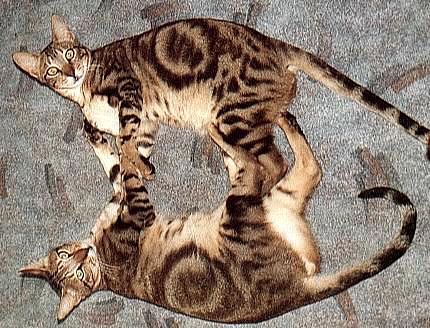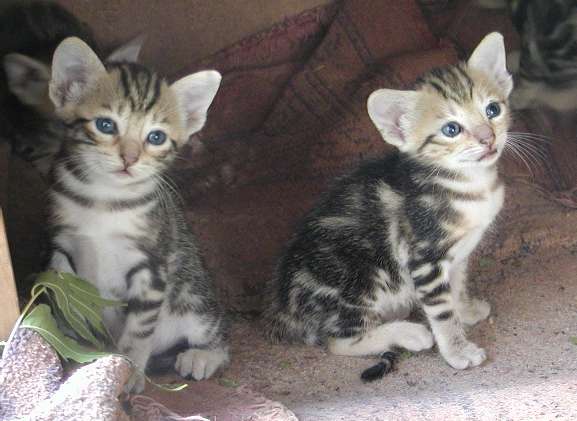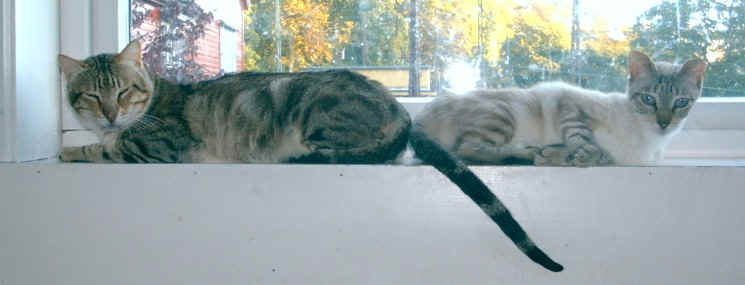|

|

What is a sokoke?
Sokoke
er en katterase fra Kenya i Afrika. Sokoken er en veldig spesiell og sjelden
katt. Per i dag finnes det 23 hunnkatter og 11 hannkatter listet som fertile.
Noen av disse 34 har aldri fått kattunger, og flere av de er antagelig ikke
fertile. I tillegg finnes de 6 små kattunger, 3 i Canada og 3 i Danmark. Forhåpentligvis
er de fleste av disse, og de andre uprøvde unge sokokene fertile, men det
gjenstår å se. De fleste fertile sokoker finnes i Danmark. I dag er det 4
sokoker i Norge, og ingen i Sverige. I mai/juni kommer det en sokoke til hit til
meg, og den første til Sverige. (den ene norske sokoken eier ikke jeg).
The sokoke is a cat breed from the coast of
Kenya, Africa. The sokoke cat is a very rare and special cat. Almost all living and fertile sokokes are in Denmark at this time.
At this time there are 23 females and 11 males listed as fertile. Some of these
34 have never gotten kittens, and several are probably not fertile. In addition
there are 6 young kittens, 3 in Canada and 3 in Denmark. Hopefully most of
these, and the other young untried sokokes are fertile. We do not yet know what
the outcome might be. Most of the fertile sokokes in the world are in Denmark.
Today there are 4 sokokes in Norway and non in Sweden. In May/June there will
arrive another sokoke at my place and the first one to Sweden (one of the
Norwegian sokkoes are not mine)

The cats has obtained it's name from the forest which it comes from, the Arabuko
Sokoke forest. This is the last larger area with the original coast forest in
Kenya. It
cover
an area of 400 square km. There are 6 species of birds and 3 species of mamals
who depend on this forest to continue to excist if their not to go extinct
(these species only excists in this forest). The Giriama tribe that lives in the forest calls this cat kadzonzo, which means: "look like tree bark".
Untill now the sokoke breeders and owners has learned that the Giriama tribe ate
the sokoke meat when food was scarece in the old days. This is not true! What
they ate, and stil eats is Genets which are weasel like creatures that has
nothing to do with cats. But they do call the sokoke Kadzonzo.
What the sokoke is, is still a mystery. Nobody knows if this is a
hybrid between African Wildcat (all domestic cats forefather) and domestic cats,
a feral domestic cat or something "all special". This belief is based
on the thought of these cats beeing different in conformation than the other
local cats, this is not true. Personally I believe the sokoke to be a feral
domestic cat that has lived in the Sokoke are for generations. Probably they've
mated to a siamese at some point as well. This is the only explanation I could
find for the snowsokokes. That a "siames point gene" should appear
twice by mutation is very unlikely. So to speak impossible.
The sokoke developed as the cat they are all by them self. They got in contact with humans in 1978. That was when Jeni Slater found two kittens on her farm in Kenya. She had never seen such a cat, and took care of them. (The picture on the left is from Jeni's farm in Kenya, and the cats on it are one of the first to be found). In 1984 Gloria Møldrup, a good friend of Jeni's, brought two cats; Jeni and Mzuri, back to Denmark. They had their first litter in 1985, and more cats where imported to Denmark in 1991. This was the early start of the sokoke breed. The breed was FiFe approved in 1993.
Breeders
of sokokes has thought for long that it wouldn't be possible to get more cats
form Kenya. We have tried for years via contacts in Kenya to get some more cats.
Now the situation seems very bright. For the first time in years there has
acutually been localised a person who has newly found sokokes in Kenya, and she
breeds them. In a while there will probably be some novice approvals for new
sokokes J
|

|
Inbreeeding
Since there are so few sokokes in the world, they have a high inbreeding coefficient. This means that the breed might be suffering from inbreeding depressions, and they might not. Anyway it is crucial to breed all fertile, healthy female cats, and almost all males. Since the cat are so inbred we are pretty sure that the breed do not suffer from any severe diseases and they do not carry any white color (like the black and white or tabby and white in many moogies, but also in different breeds).
The
colour
The
sokoke comes in one color only which is approved. This is African tabby. It
resembles the classic tabby pattern of many domestic cats. The pattern are dark
brown or black on a lighter brown or grayish brown background. The eye color
range from yellow through golden to green.
|
| Bildet er tatt av Edith
Peulicke i Kenya. Kattungene er fra Jeannie Knocker's afrikanske
sokoker; Safi x Kinky. Sokokene herfra skal forhåpetligvis bli
redningen for våre sokoker når det kommer til innavl da de vil tilføre
helt nytt blod. |
|

|
|
Snow sokoke
There do exist a snow variant of the sokoke. This is in fact an albino form in the same way as the siamese is a albino.
The cat has a beige pattern on a white background, and blue eyes. The pattern is exactly the same as the African tabby, just in other colors.
The white sokokes are not recognized as a color, but since the population are so small, these too are a part of the breeding program. It is not yet proven that the females are fertile though, only a snow male has gotten kittens with a moogie and a sokoke queen.
|
 Sokoke personality Sokoke personality
The sokoke is a very active cat. It has all kept all it's instinct form the nature, and this makes the sokoke a very special cat. If the sokoke is frightened it will freeze,
tighten it muscles, jump right up in the air and kick off with it's hind feet and flee, you wouldn't see where the cat
runs until it's gone. Flight is this cats defense. The sokoke isn't aggressive at all. It flees as long as that is a possibility, and only use teeth and claws if extremely threatened. The sokoke has refined movements and they are sprinters. They have long legs, longer hind legs than forelegs, small heads, long and slender body and lots of muscles. As a cat of the rainforest it accepts water as a part of the environment. If a river stands in it's way it will swim across, but it's not found of it. The sokoke has a unique self-esteem and is a highly intelligent cat.
|
|

Sokokes in the home
The sokoke is a social cat and enjoys the company of other cats, and even dogs (if they are used to them). The sokoke is still a "wildcat" by the looks, but it will be strongly devoted to it owners, and they are as tame as any cat. They do not demand any special equipment but settles in wherever is home. The sokoke is independent, loving, but not any sleep all day kind of cat. It may follow you around, always ready for a streak on head and back, but it does not like to be held against it will. A sokoke is not a cat to be trained with screaming and yelling. It has a sensitive mood and will follow the mood of the owner. It is independent but enjoys the company of it's owner. You could have a conversation with a sokoke fore quite a long time. The cat has a voice easily recognized and some say it has a voice a Siamese could envy
.
|
|

Is this a cat breed for me?
If you want this kind of cat:
1) A playful, living and "dog" like. A cat that in heat could make pretty much noise, and be loud.
2) A cat that won't lie in your lap for hours a day, but just as well is loving. It will come to you and fall asleep on your lap when it decides so itself. They don't like cuddling, but will follow you everywhere.
3) What to help save a rare cat breed from extinction, meaning you will have to breed these cats, if you not get a sterile cat. If you understand the importance of breeding every fertile, healthy cat and that the cat need to be shown in order to let people know of it. With this cat there comes a very challenging hobby.
4)The sokokes demand very little grooming, they hardly molt (but ofcourse they loose some hairs). All they want to thrive is good quality food, fresh water, to go to the vet at routine, and a loving, interested owner that will do everything to keep the cat happy and healthy.
If you would like such a cat, then the sokoke might very well be the cat for you.
|
|
Some
comments about the sokoke in Norway
Today
there are 4 sokokes in Norway. 3 females and 1 male. Unfortunatly it seems like
1 or 2 of these females are infertile, and possibly the male too. The male has
been fertile but he is old, 9 years old, and most likely isn't that
firtile anymore. I look to other places to mate my most likely fertile female in
Denmark. In May/June I'll get another female from Denmark, and I'm on the
lookout for a new young male.
If
someone is interessted in getting a sokoke, they'll have to be patient. Few
litters are born and it goes a long time between each litter. Usually there are
born 5-6 litters of sokokes in a year, worldwide (not including Kenya).
I
hope the first Norwegian sokoke litter will be born during spring 2003
|
Thanks to...
Heidi & Ole Lund Sørensen, Lundborg DK, for letting me use these beautiful photos of sokokes and Bob Schwartz for letting me use his
photos.
|